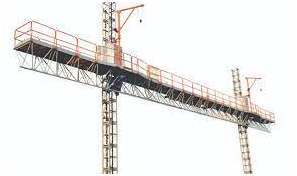Mast climbing work platforms: Failure to detect mechanical failure in drive units leading to uncontrolled fall of platforms
Industry is alerted to a serious technical fault that HSE has found with mast climbing work platforms (MCWPs) used widely across construction projects. These can be used in other industries for access and to maintain large plant.

Platforms could fall from height where mechanical faults in drive units go undetected. If not rectified quickly, the fault could cause serious injury, or even death.
This safety alert has information and advice on what to do if you supply, install, use, inspect, service, maintain or examine MCWPs for use at work.
Outline of the problem
MCWPs, also known as ’mast climbers‘, are most frequently used in construction and can be used in other industries where high-level access and maintenance are required. They can be used as an alternative to traditional scaffolding. They are comprised of a powered work platform attached to one or more vertical masts. The mechanical drive units are on the masts.
They can lift platforms with people and equipment. In construction, they provide both access and a platform from which to work on tall buildings. They can be used to attach external components such as cladding. MCWPs are used as part of cladding operations in both new build and recladding work.
HSE has discovered that some MCWPs, which rely on two independent motor drive units per mast as the means to prevent the platform falling with overspeed, are not fitted with suitable and sufficient controls to manage this risk.
This means work platforms could fall from height where mechanical faults in drive units go undetected. If not rectified quickly, the fault could cause serious injury, or even death.
Failures in drive units can be such that neither the centrifugal brakes (intended to limit the speed of descent) nor the automatic brakes (intended to engage when powered travel is stopped) within the drive units are able to have an effect.
Malfunctions in drive units which endangers proper function are foreseeable and unless a means of detection of such malfunctions is provided there is a risk of platforms falling with overspeed.
Immediate action required
You are advised immediately to check that the necessary control measures are in place for all MCWP in use or available for use at a work.
If the control measures are not in place, you need to withdraw the MCWPs from use until those responsible for supply, installation, use, inspection, servicing, maintenance and for thorough examination of MCWPs ensure that:
- there is the means to identify a loss of mechanical integrity in each drive unit where this is the system to prevent falling with overspeed
- each individual drive unit is fitted with a mechanical device, eg centrifugal brake, that automatically prevents the work platform descending at excessive speed
- damage to drive units due to platforms being powered onto buffers/base frames is prevented
- platforms and associated equipment are not damaged by physical overloading
- thorough examinations, inspections and tests, and visual and functional checks are appropriately planned and carried out
Consider the following:
Detect malfunctions in each drive unit which endanger proper function: Where two or more drive units are installed as the system to prevent falling with overspeed, you should ensure that:
- there is the means to detect malfunctions in each drive unit that could indicate a loss of mechanical integrity which results in a differential in the current demand between each drive unit, exceeding 25% of the full load current
- detection is in accordance with the manufacturer’s instructions, eg it initiates a stop command and generates audio-visual alarms
- the means of detection is functionally tested in accordance with the relevant technical standard or the manufacturer’s instructions
Prevent falling with overspeed: Where two or more drive units are installed, you should ensure that:
- each individual drive unit is fitted with a mechanical device, eg a centrifugal brake, that automatically prevents the work platform exceeding 0.4 m/s descent speed
Prevent failure of the automatic brakes you should:
- ensure operators are competent and conform to the manufacturer’s instructions for emergency lowering of the platform, eg to prevent overheating
- check brakes for wear and assess them against discard criteria in accordance with manufacturer’s instructions
- carry out functional checks of the individual automatic brake on each of the paired drive units in accordance with the manufacturer’s instructions
Prevent damage to drive units caused by contact with buffers or base frames due to the platform being powered down onto them, you should:
- ensure limit switches are appropriately positioned such that the lowest level that stopping is initiated by a terminal switch is achieved before contact with the buffers (and before contact with the final limit switch)
- Include functional tests of limit switches in checks and maintenance inspections
Prevent damage due to physical overloading you should:
- ensure limit switches are appropriately positioned such that the lowest level that stopping is initiated by a terminal switch is achieved before contact with the buffers (and before contact with the final limit switch)
- Include functional tests of limit switches in checks and maintenance inspections
Prevent failure due to defects or deterioration being undetected, as part of your risk management and control arrangements, you should:
- review your risk assessment with a focus on periodicity of inspections and thorough examinations and tests, with reference to national regulations and the manufacturer’s manual
- ensure periodic inspections, measurements and checks include those items listed by the manufacturer in their maintenance and service schedule
- ensure checks and inspections are undertaken only by those competent to do so
Or you need to take equally effective measures required to comply with Regulation 4 of the Provision and Use of Work Equipment Regulations 1998
HSE action
Where MCWPs are found in use or available for use without suitable controls to manage the risk set out above HSE enforcement action will be taken in line with our enforcement policy and procedures.
Relevant legal provisions
Regulation 4 of the Provision and Use of Work Equipment Regulations 1998 (PUWER) requires machinery to be constructed or adapted to be suitable for the purpose for which it is provided or used.
For the system comprising two or more independent and identical electric motor direct drive units fitted to each mast there are additional requirements including:
‘Detect malfunctions in each drive unit which endanger proper function. These shall at least indicate a loss of mechanical integrity which results in a different in the current demand between each drive unit, exceeding 25% of the full load current’.
Consistent, for example, with one drive unit doing all the work due to a loss of mechanical integrity in the other unit in a pair.
and
‘Each drive unit fitted with a mechanical device that automatically prevents the work platform exceeding 0.4 m/s descent speed. Each such speed limiting device, when acting on its own, shall be capable of carrying the work platform and its rated load in the most disadvantageous configuration...’
It has been found that on some platforms only one drive unit of the pair is fitted with a centrifugal brake.
Definition of drive unit:
Within this safety alert a drive unit is defined as a single motor assembly consisting of one motor and the associated drive equipment including reduction gearbox, electromagnetic brake, centrifugal brake, and pinion



